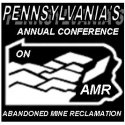March 8, 2011 – The Eastern Pennsylvania Coalition for Abandoned Mine Reclamation (EPCAMR) and a team of experts from the Pennsylvania Department of Environmental Protection (PADEP) Pottsville District Mining Office, the PADEP Bureau of Abandoned Mine Reclamation (BAMR), the U.S. Geological Survey (USGS) Pennsylvania Water Science Center, and the Office of Surface Mining (OSM) Appalachian Regional Office have been working on a 4 year study of water quantity, quality, and potential usage from underground mines in the Anthracite region. A majority of this study was funded by a Growing Greener grant from the PADEP and a grant from the Foundation for Pennsylvania Watersheds. The objective of this project is to determine the immediate and long-term availability (water quantity and water quality) of mine-water resources in the Western Middle and Southern Anthracite Fields of Eastern Pennsylvania.
The project involves the compilation, evaluation, and synthesis of data on the hydrogeology of flooded underground mines. Information maintained in paper files by State and Federal authorities was digitized and combined with other available data to develop a comprehensive geographic information system (GIS) database containing the locations, topographic elevations, water-level elevations, flow rates, and water quality in wells, boreholes, abandoned mine drainage (AMD) sources, and associated stream reaches throughout the region. Additional data on the locations of coal outcrops, barrier pillars, and mine boundaries will be included in the GIS database. This data will be evaluated to delineate horizontal and vertical boundaries and to estimate corresponding current flooded volumes for the major mine pools, also know as multi-colliery hydrogeologic units. The associated recharge area(s) and primary discharge points for each of the major mine pools will be identified considering digital topographic, mine map, and aerial photography data.
In the Western Middle Field, where large pumping wells are in place or could be considered to extract water from the mine pools, USGS produced a ground-water modeling report to estimate hydrological properties including the recharge, discharge, hydraulic conductivity, and storage in the mine pool. The modeling estimates of the drawdown area of influence from large pumping wells, the sustainable discharge volume (specific yield), and the potential effects on associated AMD discharge rates and stream base-flow volumes. Considering the effects of different variables (hydraulic conductivity, recharge rate, pumping rate) and corresponding outcomes (mine pool water levels, AMD flow rates and chemistry), the modeling results will help guide the collection of new data in areas where adverse effects could result. That report can be accessed by the USGS webpage.
The full report is still being compiled and will be released later this year. It will explain in detail the hydrogeological characteristics of each mine pool in the Western Middle Field and the results of the GIS and ground-water resources analysis will be displayed as maps that identify the quantity and quality of the mine-pool water resources. The maps will be useful to guide land-use managers as well as public and private interests concerned with water availability and economic redevelopment in Pennsylvania’s Southern and Western Middle Anthracite Region. EPCAMR plans to continue this work for the Northern and Eastern Middle Fields as well.











